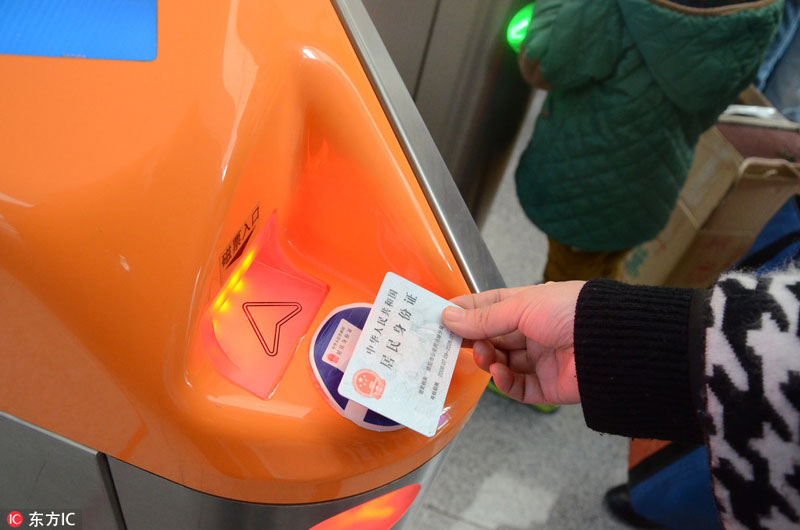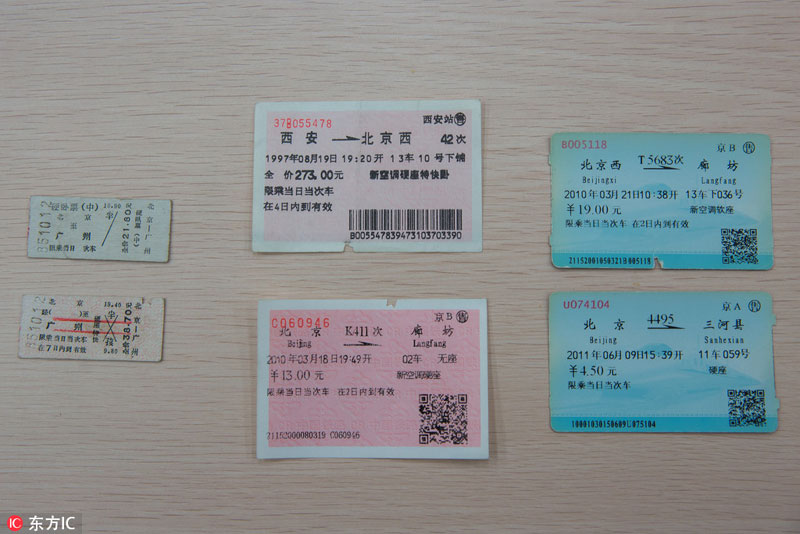


A passenger swipes an ID card on a self-service machine to take the train at Chengdu East Railway Station, Jan 20, 2015. [Photo/IC]
China plans to roll out E-tickets for high-speed trains across the country in 2019, said Lu Dongfu, general manager of China Railway Corp at a recent forum.
Passengers will be able to tap their smartphones or ID cards against a card reader at the ticket barrier to enter the station, Lu said.
In recent years, travelers in Beijing, Shanghai, Guangzhou, Shenzhen and other major second-tier cities have been able to use their ID cards to get on high speed trains, while passengers in remote areas still need paper tickets to take the train. The good news is that as early as the fourth quarter of this year, pilot projects for E-tickets will be launched at some railway stations, Wuhan Railway Administration said.
Electronic payment and tickets have profoundly changed people's lives since they have become increasingly popular for commuters to take the bus and metro in China. In this way, the advanced technology will help passengers save the time involved in using paper tickets, making travel more convenient and comfortable.
Besides that, E-tickets are more eco-friendly, as there is no need for special paper and ink to print paper tickets, and personal information leaked from abandoned tickets will not happen thanks to the technology, China Railway Guangzhou Group said.
Starting in the 1940s, China's train tickets have gone through four generations of improvement. Compared to the hardboard paper in the first generation and soft paper in the next, the third generation features a magnetic medium to record ticket information, which can be used on self-service ticket checking machines. Since 2011, passengers have been able to use their ID cards on self-service machines to take high speed trains in certain cities.

The first to third generation of paper tickets for Chinese trains are seen, from left to right. [Photo/IC]

 Award-winning photos show poverty reduction achievements in NE China's Jilin province
Award-winning photos show poverty reduction achievements in NE China's Jilin province People dance to greet advent of New Year in Ameiqituo Town, Guizhou
People dance to greet advent of New Year in Ameiqituo Town, Guizhou Fire brigade in Shanghai holds group wedding
Fire brigade in Shanghai holds group wedding Tourists enjoy ice sculptures in Datan Town, north China
Tourists enjoy ice sculptures in Datan Town, north China Sunset scenery of Dayan Pagoda in Xi'an
Sunset scenery of Dayan Pagoda in Xi'an Tourists have fun at scenic spot in Nanlong Town, NW China
Tourists have fun at scenic spot in Nanlong Town, NW China Harbin attracts tourists by making best use of ice in winter
Harbin attracts tourists by making best use of ice in winter In pics: FIS Alpine Ski Women's World Cup Slalom
In pics: FIS Alpine Ski Women's World Cup Slalom Black-necked cranes rest at reservoir in Lhunzhub County, Lhasa
Black-necked cranes rest at reservoir in Lhunzhub County, Lhasa China's FAST telescope will be available to foreign scientists in April
China's FAST telescope will be available to foreign scientists in April